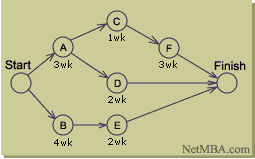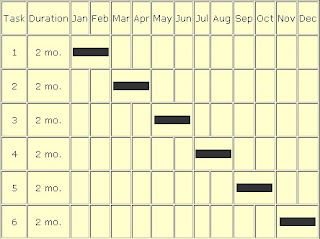Patel and Morris have stated that
"The life cycle is the only thing that uniquely distinguishes projects from non-projects".
So, what is the project life cycle?The Project Life Cycle refers to a logical sequence of activities to accomplish the project’s goals or objectives.Regardless of scope or complexity, any project goes through a series of stages during its life. There is first an Initiating or Birth phase, Planning phase, Execution and Controlling and also Closing phase.
Project Initiating
In this first stage, the scope of the project is defined along with the approach to be taken to deliver the desired outputs. The project manager is appointed and in turn, he selects the team members based on their skills and experience. The most common tools or methodologies used in the initiation stage are Project Charter, Project Feasibility, Business Case, Job Description, Project Check list.
Project Charter:
- Identify the project vision and objectives
- Define the complete scope of the project
- List all of the critical project deliverables
- State the customers and project stakeholders
- List the key roles and their responsibilities
- Create an organizational structure for the project
- Document the overall implementation plan
- List any risks, issues and assumptions
The Project Charter defines the vision and boundaries for the project, as well as the high level roadmap. In addition, the Project Charter also defines the scope of the project, within which the deliverables are produced. With a well defined Project Charter, the Project Manager has a clear project roadmap for success.
Business Case:
- Research the business problem or opportunity
- Identify the alternative solutions available
- Quantify the benefits and costs of each solution
- Recommend a preferred solution to your sponsor
- Identify any risks and issues with implementation
- Present the solution for funding approval
The Business Plan is referred to frequently during the project, to determine whether it is currently on track. And at the end of the project, success is measured against the ability to meet the objectives defined in the Business Plan. So the completion of a Business Plan is critical to the success of the project.
Project Feasibility:
- Research the business problem or opportunity
- Document the business requirements for a solution
- Identify all of the alternative solutions available
- Review each solution to determine its feasibility
- List any risks and issues with each solution
- Choose a preferred solution for implementation
- Document the results in a feasibility report
The purpose of a Feasibility Study is to identify the likelihood of one or more solutions meeting the stated business requirements. In other words, if you are unsure whether your solution will deliver the outcome you want, then a Project Feasibility Study will help gain that clarity. During the Feasibility Study, a variety of 'assessment' methods are undertaken. The outcome of the Feasibility Study is a confirmed solution for implementation.
Job Description:
- Define the real purpose of the role
- List the key responsibilities of the role
- Define who this role will be reporting to
- Create a detailed Organizational Chart
- List the skills and experience needed
- Define any relevant qualifications
- Set out the key performance criteria
- Identify the salary and working conditions
A Project Job Description should be completed every time a new role is identified. The Project Job Description should clearly state the objectives and responsibilities of the role and where it fits within the organizational structure
Project Office Check List:
- Identify the right location for your PMO (Project Management Officer) team
- Ensure that you have the correct infrastructure
- Procure the right PMO equipment and tools
- Define the PMO roles and responsibilities
- Put in place suitable standards and processes
- Implement relevant project management templates
- Offer Project Management Office services to projects.
A Project Office Checklist helps you to establish and operate a Project Management Office. This Project Office Checklist contains a list of items to help you determine whether; the Project Office premises are fit for purpose, you have sufficient equipment available and whether all of the roles, standards and processes are in place within your Project Management Office environment.

Project Planning
The second phase should include a detailed identification and assignment of each task until the end of the project. It should also include a risk analysis and a definition of a criteria for the successful completion of each deliverable. The governance process is defined, stake holders identified and reporting frequency and channels agreed. The most common tools or methodologies used in the planning stage are Work Breakdown Structure (WBS) and Gantt Chart.
Work Breakdown Structure
Work Breakdown Structure is a complex project is made managable by first breaking it down into individual components in a hierarchical structure.
Work Breakdown Structure Diagram
The work breakdown structure is the foundation of project planning. It is developed before dependencies are identified and activity durations are estimated. The WBS can be used to identify the tasks in the CPM and PERT project planning models.
CPM- Critical Path Method
CPM models the activities and events of a project as a network. Activities are depicted as nodes on the network and events that signify the beginning or ending of activities are depicted as arcs or lines between the nodes.
CPM Diagram

Gantt Chart
Gantt Chart is a tool for displaying the progression of a project in the form of a specialized chart. It is schedule tool takes the form of a horizontal bar graph.
Gantt Chart Format

Closing Phase
Project Closure Phase is the last phase of the Project Life Cycle. The commencement of the Project Closure Phase is determined by the completion of all Project Objectives and acceptance of the end product by the customer.

Preview Notes:
http://docs.google.com/leaf?id=0B_8uDc2mM3boM2JhZGEwNzYtOGNlNC00NjZmLTlmZTUtYTZiMjRiNDQ5N2I1&hl=en&authkey=CPPD1fIO
Project Charter:
reference http://www.projectinitiation.com/process_assets/Project%20Charter%20Template.doc
Source:
The second phase should include a detailed identification and assignment of each task until the end of the project. It should also include a risk analysis and a definition of a criteria for the successful completion of each deliverable. The governance process is defined, stake holders identified and reporting frequency and channels agreed. The most common tools or methodologies used in the planning stage are Work Breakdown Structure (WBS) and Gantt Chart.
Work Breakdown Structure
Work Breakdown Structure is a complex project is made managable by first breaking it down into individual components in a hierarchical structure.
Work Breakdown Structure Diagram
The work breakdown structure is the foundation of project planning. It is developed before dependencies are identified and activity durations are estimated. The WBS can be used to identify the tasks in the CPM and PERT project planning models.
CPM- Critical Path Method
CPM models the activities and events of a project as a network. Activities are depicted as nodes on the network and events that signify the beginning or ending of activities are depicted as arcs or lines between the nodes.
CPM Diagram

Steps in CPM Project Planning
- Specify the individual activities.
- Determine the sequence of those activities.
- Draw a network diagram.
- Estimate the completion time for each activity.
- Identify the critical path (longest path through the network)
- Update the CPM diagram as the project progresses.
Gantt Chart
Gantt Chart is a tool for displaying the progression of a project in the form of a specialized chart. It is schedule tool takes the form of a horizontal bar graph.
Gantt Chart Format

Project Execution and Controlling
Project Execution and Control Phase follows the Project Planning Phase and ideally starts once the Project Plan has been approved and baselined. Project Execution is characterized by the actual work on the tasks planned and project Control involves the comparison of the actual performance with the planned performance and taking appropriate corrective action to get the desired output.
Project Execution and Control Phase follows the Project Planning Phase and ideally starts once the Project Plan has been approved and baselined. Project Execution is characterized by the actual work on the tasks planned and project Control involves the comparison of the actual performance with the planned performance and taking appropriate corrective action to get the desired output.
The basic processes of the Project Execution and Control can be:
- Project Plan Execution.
- Review of Metrics and Status Reports.
- Change Control Process. This defines the procedures to handle the changes that are introduced
- during Project Execution and Control.
The facilitating processes during Project Execution and Control can be:
- Quality Assurance and Quality Control.
- Performance Monitoring.
- Information Distribution or Status Reporting.
- Project Administration.
- Risk Monitoring and Control.
- Scope Control.
- Schedule and Cost Control.
- Contract Administration.
Closing Phase
Project Closure Phase is the last phase of the Project Life Cycle. The commencement of the Project Closure Phase is determined by the completion of all Project Objectives and acceptance of the end product by the customer.
Project Closure includes the following tasks:
- Release of the resources, both staff and non-staff, and their redistribution and reallocation to other projects, if needed.
- Closure of any financial issues like labour, contract etc.
- Collection and Completion of All Project Records.
- Archiving of All Project Records.
- Documenting the Issues faced in the Project and their resolution. This helps other projects to plan for such type of issues in the Project Initiation Phase itself.
- Recording lesson learn and conducting a session with the project team on the same. This helps in the productivity improvement of the team and helps identify the dos and donts of the Project.
- Celebrate the Project Completion. Its party time folks!!!
The basic process of the Project Closure Phase involves:
- Administrative Closure. This is the process of preparation of closure documents and process deliverables. This includes the release and redistribution of the Project Resources.
- Development of Project Post Implementation Evaluation Report. It includes
- Project Sign-Off
- Staffing and Skills
- Project Organizational Structure
- Schedule Management
- Cost Management
- Quality Management
- Configuration Management
- Customer Expectations Management
- Lesson Learn

Preview Notes:
http://docs.google.com/leaf?id=0B_8uDc2mM3boM2JhZGEwNzYtOGNlNC00NjZmLTlmZTUtYTZiMjRiNDQ5N2I1&hl=en&authkey=CPPD1fIO
Project Charter:
reference http://www.projectinitiation.com/process_assets/Project%20Charter%20Template.doc
Source:
- www.maxwideman.com/papers/plc-models/plc-models.pdf
- http://www.netmba.com/operations/project/cpm/












